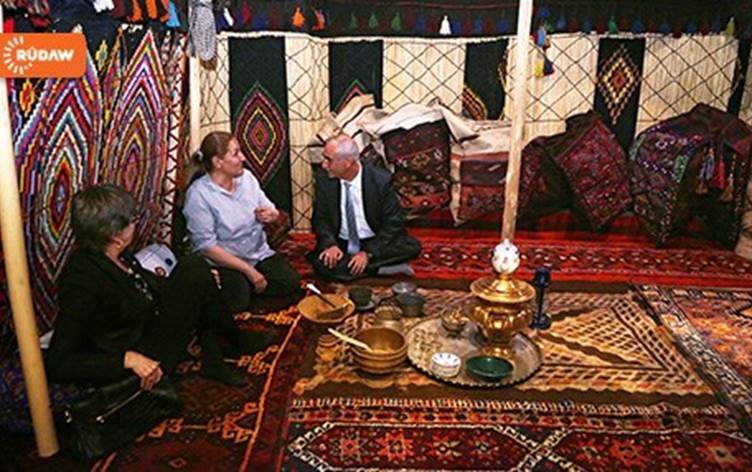ERBIL, Kurdistan Region – More than a year after the festive reopening of the Kurdistan Textile and Cultural Museum at the Erbil Citadel in the Kurdistan Region, owner Lolan Sipan is struggling to keep its doors open.
Due to the impact of Kurdistan’s war with the Islamic State group (ISIS) – which has continued since August last year -- he has been forced to send almost all of his staff away and close the museum tea house.
In April 2014 the museum that Sipan had set up 10 years before in a corner of the Citadel reopened its doors after an extensive renovation, paid jointly with German and local funding.
It was part of the revitalization of the Erbil Citadel, which has since been added to the World Heritage list of UNESCO.
The museum suffers from the threat from ISIS and fighting that is raging only miles from the capital. The war has halted the development of the Kurdistan Region into a popular tourist destination and kept most tourists away.
In addition, the revitalization of the Citadel has almost been stopped because government funds are being drained by the war. Economic woes have been compounded by some two million Syrian refugees and internally displaced who have taken refuge in Iraqi Kurdistan.
That has also had an impact on the number of visitors to the museum.
Presently, the only entrance is at the back of the Citadel, away from the bazaar, where people need to pass a checkpoint on foot, climb a steep entrance road and walk across the dusty building site to the museum. A new front gate has been ready since last year, but still has not been opened, Sipan points out.
“It has been promised many times. It will bring the museum nearer to the people, and locals might come back again too, to have a tea in our teashop,” Sipan hopes.
Before the restoration work began, the Citadel could be reached through the old front gate. It would attract thousands of visitors a week, and the museum would take its share of a couple of hundreds, Sipan says.
“Then we would have to close the museum during local holidays, as we could not manage the number of visitors eager to come. Now, we only have a couple of dozen a week at most, mostly foreigners; locals don’t seem to know we have reopened.”
Because of drop in revenues, he paid his staff from his own pocket for a while, before laying off 10. He is now left with only one paid staff member and some volunteers. “But they will leave when the schools start again.”
Yet the few tourists who visit Kurdistan and do find the museum leave enthusiastic comments on Tripadvisor, such as “magical,” “a must see,” and “a jewel of Kurdistan.”
One of the guides at the Citadel who used to take groups of tourists around confirms that since a year he has hardly had any clients. He calls the reopening of the front gate essential to revive the place.
In the revitalization plan the citadel was designated as a cultural destination, with art and cafés to attract visitors. As yet, the Textile Museum is one of the few places that are open.
IFPO, the French Institute for the Middle East that is located in the Chalabi House next door, occasionally organizes seminars and meetings. And there is talk of a Gems and Stones Museum opening soon near the new front gate.
Sipan offers the teashop on the second floor of the museum to organizations and others for meetings or seminars, but in the present situation is not able to attract them.
Eleven years ago he set up the museum to prevent the Kurdish tradition of carpet weaving from becoming extinct. With American help, a weaving project was started, where the older women would teach their tradition and skills to the younger. What they made was sold in the museum gift shop.
“We invested in a house in the Citadel for the project,” said Sipan. “We installed the women there and they had a job. They were making a high quality product.”
The project has been stopped for lack of funding.
“Even the middle class Kurds are not interested in their culture and traditions. They only want modern fashion,” Sipan laments.
He says he is looking for other ways to restart the weaving project, for instance by involving internally displaced women, as he deems it essential to keep the carpet weaving culture alive: “The trend here is to westernize.”
He admits that the threat of ISIS and the thousands of casualties the group has afflicted on the Kurdish Peshmerga have a huge effect on life in Kurdistan.
But if he can no longer keep the museum open, that would be a waste of the money foreign countries and local authorities have donated to it, he states.
“And once it is gone, it will be very difficult to bring it back.”




Comments
Rudaw moderates all comments submitted on our website. We welcome comments which are relevant to the article and encourage further discussion about the issues that matter to you. We also welcome constructive criticism about Rudaw.
To be approved for publication, however, your comments must meet our community guidelines.
We will not tolerate the following: profanity, threats, personal attacks, vulgarity, abuse (such as sexism, racism, homophobia or xenophobia), or commercial or personal promotion.
Comments that do not meet our guidelines will be rejected. Comments are not edited – they are either approved or rejected.
Post a comment